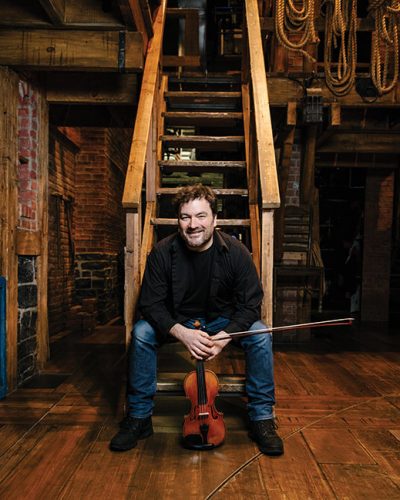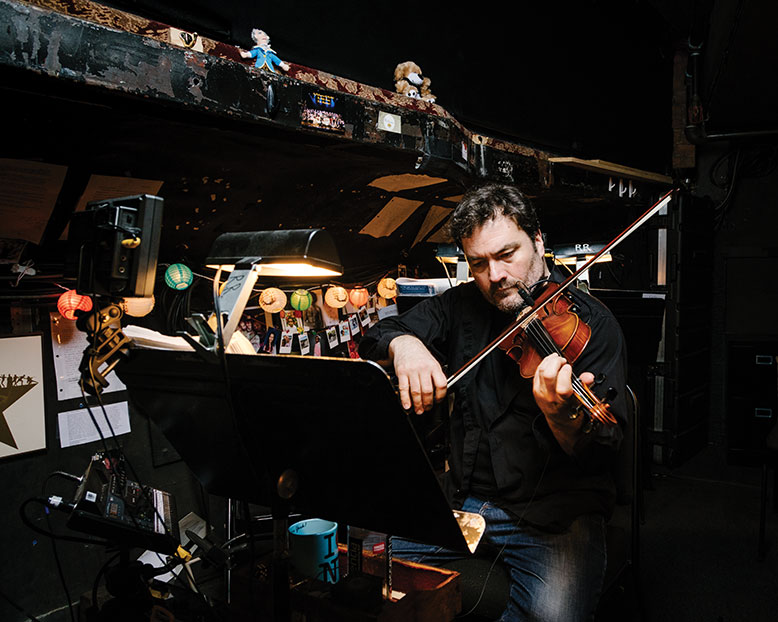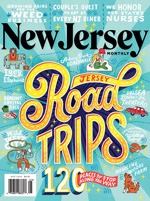
When you work in a Broadway orchestra you can wear any color you want, as long as it’s black. For a recent matinee performance of Hamilton, concertmaster and first violinist Jonathan Dinklage donned a black shirt—unbuttoned and untucked—with black T-shirt underneath.
Dinklage’s workplace for six shows a week is under the stage in the orchestra pit at the Richard Rodgers Theatre. At first peek, the pit seems claustrophobic, like a dark and narrow cellar. “Actually,” says Dinklage, “the pit here is pretty spacious. There are only 10 in this orchestra. A lot of these theaters smash more people into a space like this.” Like the musicians, the pit is dressed in black: black carpet, black walls, black ceiling.
It’s half an hour before showtime and the musicians are filtering into the theater and milling around the trap room, the crammed common area beneath the stage and behind the pit. Stagehands gab at a snack table, picking at salads. Nearby, white ruffled shirts and crisply ironed vests and leggings fill the costume rack.
For the entire company, it’s exhilarating to be part of Broadway’s biggest hit. At the time of this early-April matinee, Hamilton had surpassed 1,100 performances. Dinklage, who was born in Point Pleasant and raised in the Brookside section of Mendham Township, estimates he’s played close to 800 of them.
Despite his contribution to the production, Dinklage labors in anonymity. If his name sounds familiar, that’s because his younger brother is the actor Peter Dinklage, star of HBO’s Game of Thrones.
At 1:43 pm, an alert comes over the backstage loudspeaker: 15 minutes to show time. In the trap room, the drummer joins several cast members in a pre-show prayer circle. One by one, the members of the orchestra slip through the narrow doorway to the pit, settling into their seats to tune up. Dinklage and the rest of the four-person string section, along with the guitarist and keyboard player, are positioned under stage right. The bassist, percussionist and drummer are under stage left. All face the conductor, who sits at a keyboard on a riser at the center of the pit, four feet above the others, his head poking through the narrow opening at the front of the stage. Someone has taped a row of Alexander Hamilton 10-dollar bills to the inner rim of the opening.
For Dinklage, there’s no better place to be. “The most important gig in New York right now is Broadway,” he says. “It provides a good sense of security when a show is doing so well.” What’s more, the work provides flexibility for Dinklage’s other—even more satisfying—work as a freelance studio musician. The 51-year-old has performed on violin and viola on some 100 recordings for such music giants as Michael Jackson, Stevie Wonder and Barbra Streisand. He’s also played on movie soundtracks and original cast albums and currently records the strings for the ABC drama series The Good Doctor.
Dinklage has amassed Broadway credits as a regular or substitute player for about 15 shows. “Most of them didn’t last,” he says. He was the concertmaster for the musical Matilda when a friend asked him to play for the first reading of a new hip-hop musical about Alexander Hamilton.
Dinklage wasn’t thrilled with the invitation. “Readings don’t pay very much,” he says. “You work hard all week. I was on the fence about doing it because I had a job.”
His outlook changed quickly. “The second we started playing, I knew something crazy was happening,” he says. “I knew I had to be part of it.” He said goodbye to Matilda and hello to Hamilton.
As concertmaster, Dinklage leads the string section and takes most of the solos—although violin solos are few in the Hamilton score. Under union rules, the concertmaster earns slightly more than the other strings.
As curtain time nears, Dinklage reflects on the pit’s distinctive clutter. “It’s decorated to feel like home,” he says. Paperbacks, gift-wrapped wine bottles, assorted toys, iPads, cables and junction boxes are scattered around the musicians’ chairs and music stands. The pit measures 9 feet front to back and runs the full 45-foot width of the stage. At places, it is tall enough to stand, but steel beams supporting the stage vary the pit’s height. Along the front wall, a string of miniature Chinese lanterns sheds a soft light on the musicians.
The orchestra this afternoon consists of five regulars and five substitutes, a typical situation, Dinklage explains. He turns to the new sub on viola and offers simple encouragement: “Have a good ride.” The other players make small talk and send last-minute texts. The house lights dim, and a muffled roar from the audience filters into the pit. The musicians put on their headsets as the conductor counts down for the opening ensemble number, “Alexander Hamilton.” Another performance of Broadway’s hottest smash has begun.
Other than the conductor, whose head occasionally bobs into view at the front of the stage, the orchestra is hidden from the audience. Likewise, the musicians are isolated from the stage above them. They watch the action on video monitors and listen to the actors—and each other—through their headsets, in which they also hear the constant tick-tick-tick of the click track—sort of an electronic metronome—that helps them stay on the beat.
Dinklage first picked up the violin in elementary school after his parents took him to a performance of the New Jersey Symphony. Their seats happened to be in front of the violin section. “I was blown away,” he says. By fourth grade, he was playing violin in the Abbey Orchestra, a community group conducted by Roy Horton, music director at Delbarton, the private school in Morristown. Horton became a mentor, as did Dinklage’s first violin teacher, Father Germain Fritz.
Music was a constant in the Dinklage home. Jonathan’s mother, Diane, a Newark native, was an elementary school music and chorus teacher in Roxbury Township. Retired now, she still lives in Mendham. His father, John, was an insurance salesman and, Dinklage says proudly, an “incredible craftsman” who made his own split-bamboo fly rods. John Dinklage, a Glen Ridge native, loved nature and fly-fishing. He died of cancer in 2004.
Although schooled in classical repertoire, Dinklage was mainly drawn to rock and jazz. At home, he improvised on violin along to rock records and TV commercials. By eighth grade he was playing his prize instrument, a white Barcus-Berry electric violin, in local bands, covering the music of Van Halen and other rock favorites. When it came time to enter high school, the natural choice was Delbarton. His musical education later continued at the Mason Gross School of the Arts at Rutgers.

Dinklage in the pit, tuning up for a matinee. Photo by Axel Dupex
In his narrow, padded chair beneath the Hamilton stage, Dinklage maintains perfect posture and rocks to the beat as he bows and plucks his violin. The score on his music stand is almost 2 inches thick—50 numbers in all. The playing is virtually constant. “There’s no stop for dialog,” Dinklage says. “It’s through-composed.” The work is demanding, yet Dinklage seems relaxed, almost in a dream state. Halfway through the first act, he puts his violin back on its stand. There are no violin parts for 2 minutes and 40 seconds. “This is our bathroom break,” he says. He and his fellow violinist scoot out of the pit.
Dinklage returns to his chair right on time, of course. When the music finally stops at intermission, he declares, “Ta-da!” The afternoon’s performance is halfway done.
After graduating from Mason Gross, Dinklage returned to Delbarton to teach. He got his first career break playing violin for a Sylvan Learning Center commercial. He still has his first residual check, a $38 payment he never cashed.
The work soon became more memorable. Dinklage played on several of Rod Stewart’s Songbook albums and in the string section for a 2001 performance by Michael Jackson at Madison Square Garden. After the Jackson show, Dinklage was so excited he ran all the way up 8th Avenue to his apartment on 48th Street. He did string arrangements for two Mary J. Blige tours and played on two Barbra Streisand tours. That was a great gig—only two shows per week. “We arrived in Paris on Tuesday and the concert wasn’t until Friday,” he recalls. He has performed with Tony Bennett and Lady Gaga, and accompanied Gaga at the 2018 Grammy Awards. Last year, in a demonstration of his versatility, he played the Grammys behind country artist Sturgill Simpson.
Going on tour with the rock band Rush in 2013 and 2015 was, says Dinklage, “the highlight of all.” The Rush tours gave him the opportunity to play solos onstage with the band. They also resulted in lasting friendships with Rush co-founders Geddy Lee and Alex Lifeson. In an e-mail interview, Lee describes his admiration for Dinklage—the player and the person.
“Jonny has the ability to seamlessly blend in to a string section or stand out as a virtuoso soloist,” writes Lee. “There is a lot of power in his playing, so he can be as delicate as the part requires and yet crank it up when need be.”
He calls Dinklage “a great team player,” adding, “Jonny is a fantastic and hilarious guy…. He was a pleasure to have along with us.”
Dinklage’s brother, Peter, is another close friend. The more famous Dinklage was born with achondroplasia, a common form of dwarfism. Those with the condition have a normal-sized head and torso, but shorter arms and legs. Dinklage remembers being “overprotective” of his younger brother, but that didn’t last long. “He always stood for himself,” Dinklage says. What’s more, the Mendham community was very supportive of Peter. As children, the two brothers staged puppet shows in their basement, once performing the Who’s Quadrophenia for their neighbors. And just as Jonathan developed a desire to play music, Peter developed a passion for acting.
“With my father and mother, there wasn’t a single question that we should do anything else,” says Dinklage. He describes his brother as “shy and private” and “a monster actor.” Every year, Dinklage travels with his mother to Ireland during the shooting of Game of Thrones to spend time with Peter and Peter’s wife and two children.
Dinklage lives alone in his combination apartment/recording studio in Central Harlem. He and his wife, the actress Ta’Rea Campbell, recently separated, but remain good friends. (Campbell is currently appearing in the key role of Angelica Schuyler in the national tour of Hamilton.) Dinklage returns to Mendham at least once a week on a day off to visit his mother. “The backyard, the hammock, the grill. It’s a good respite,” he says.
For Dinklage, the romantic and often tragic second act of Hamilton can be even tougher than the first. “Physically, it’s easier,” he says, “but there’s more at stake emotionally.” The show ends with a mournful violin solo as Eliza, Hamilton’s widow, ponders the future. After the final note, the actors take their bows. For a brief moment, the conductor rises from the pit and gestures toward the unseen orchestra. The audience applauds with enthusiasm—the only acknowledgement that there are real, live musicians stashed under the stage.
That makes no difference to Dinklage. “It’s always fun,” he says, as he unwinds in the trap room after the performance. Behind a nearby curtain, the women of the cast are giggling as they change out of their costumes. It’s exhilarating to be part of Broadway’s biggest hit.

Great article…thank you!
I sat with Johnny during a show last year. He is an amazing talent and a super generous man. Kudos for featuring him. His generosity has changed my life as he shared his talents with me during Hamilton for one performance. That’s all it took-ONE performance-to understand the workings of a Broadway show and to understand his extraordinary talent.
Thank you for shining the spotlight on this accomplished and talented man, Jonathan Dinklage. Very enlightening article!
Hi
https://google.com/#btnI=rutigunu&q=ichatster.com&ab=klsmfpglba
My id 456424